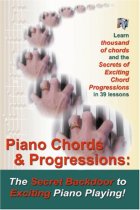A Fun Way To Practice Runs & Fills!
Have Some Fun With Runs & Fills!
| Duane: | Good morning, this Duane. Today, I’d like to show you a fun way to practice runs and fills, all kinds of right hand variations. You can do it with any chord progression at all, but I recommend the simple chord progression of 1, 6, 2, 5. We all recognize the … (music) that Blue Moon chord progression, which is in the key of C. It would be C, A minor, D minor 7th, G 7th. To make it a little more interesting, on the C major, you could put in a 6th if you want. On A minor, put in a 7th there, so make it A minor 7th. This is just to make it easier. You don’t have to if you don’t want to. D minor, make it a 7th, and G 7th, a four note chord, all four note chords. C6.
|
| I’ll do it from the root so you can see it. That’s C major 6. This is A minor 7th, D minor 7th, and G 7th. I’m going to play it inverted as well so you can have practice playing it in all ways. For example, in the left hand, all you need to do is keep a chord pattern going between those four chords. D minor, G7, C, A minor, D minor, G7. Just get something like that going. In your right hand, just take the chord, whatever it is, and break it up. Like this. That’s a C 6 chord being broken up. Here’s an A minor 7th chord being broken down. Here’s a D minor 7th chord being broken up. Here’s a G 7th chord being broken up. See how simple that is?
|
|
| Now you can mix it up, though. Here’s a C major, A minor coming down, D minor, G, C, D minor, G 7th. See I’m just playing random notes, but out of that chord. It’s a good way to start improvising, too, as well as runs. See how I’m just making up a melody out of the notes. You can do that endlessly. Let me speed it up a little bit now. I just took the A minor chord and broke it up like that, tucked my thumb under. When I’m ready to come down, go down the same way if you want. When I get up there, I’ll probably come down the A minor 7th chord, maybe up the D minor 7th chord, and down the G 7th chord. I can pause. I don’t have to go straight up. I could go … Let me just do it a little bit …
|
|
| It’s just a fun way to practice so you can get a lot of different things going in your right hand. Those were runs but I played some single notes, too, as you noticed. What I didn’t do is I didn’t use a straddle or a two on or a three one. Here’s a straddling. You take any two notes of a chord and leave one out, then play the other two notes. You can do that. See that sort of thing. Or three one means you hit three notes, then one. Three, one, three, one, three, one, three, one, three, one, three, one, three, one, three, one, three, one, three, one, three, one, three, one, three, one, three, one, three, one. Okay? Lots and lots of varieties.
|
|
| Just some fun ideas to practice your runs and fills and it’ll lead into improvisations. Thanks for being with me and if you enjoy these little video tips come on over to playpiano.com and sign up for all of them. Thanks. Bye-bye for now.
|
Click on this link to watch this video on YouTube: https://www.youtube.com/watch?v=oW7WW4LrZFk&feature=youtu.be
***For lots more good stuff on piano playing come on over to my website at https://www.playpiano.com and sign up for our free piano tips – “Exciting Piano Chords & Sizzling Chord Progressions!”
Here’s a great little book on chords and chord progressions on Amazon: http://www.amazon.com/Piano-Chords-Chord-Progressions-Exciting-ebook/dp/B0076OUGDE/ref=sr_1_1?s=books&ie=UTF8&qid=1404158669&sr=1-1&keywords=piano+chords+duane+shinn





